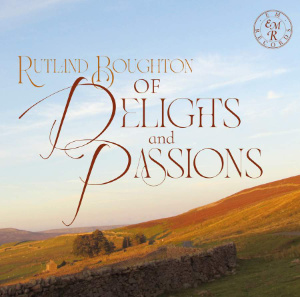
Rutland Boughton (1878-1960)
Of Delights and Passions
Piano Trio (1948)
Violin Sonata (1921)
Cello Sonata (1948)
Celtic Prelude (The Land of Heart’s Desire), for piano trio (1917)
Winter Sun, for violin and piano (1932)
English Piano Trio
rec. 2022, SJE Arts, Oxford
EM Records EMRCD081 [67]
With the exception of the Celtic Prelude, the works on this disc are all new to Rutland Boughton’s discography. Though he’s best known for his Glastonbury Festivals and for his choral and stage works he did write a significant body of chamber music, some of which – such as the flute and oboe works and his string quartets – have already been recorded.
Boughton’s greatest gift was his unbounded lyricism, and this quality pervades all the newly recorded works. Take the Piano Trio of 1948 with which the disc opens. Though it’s a diptych, balancing ardour with jauntiness, it’s finely constructed and compact, spontaneous-seeming fluency generating a compelling confident stride by the first movement’s end. The second movement offers a folklike dance that generates ever more spiritoso generosity.
Written on a wider canvas is the Violin Sonata of 1921, finely played by violinist Jane Faulkner and pianist Timothy Ravenscroft, in which each movement carries a motto from Nietzsche’s Also sprach Zarathustra, indicative here of general elation and states of being, rather than having any philosophical or other significance. That of the slow movement (‘Of Delights and Passions’) is, in fact, the title of EM’s disc. It’s a rather blithe and joyful work for the time and structured on standard sonata form with confident handling of material which becomes, toward the end of the first movement, increasingly passionate. The central movement balances intimacy with a certain unsettled temper before a folksong intimation insinuates itself into a hornpipe. The finale is generally light-hearted, energetic and decisive. The notes speak of a chromatic theme in the finale that represents the Devil. Maybe so, but he’s rather tame and not especially sulphurous. This is a generous-minded and warm-hearted work though it’s best not to compare and contrast with Ireland’s Second Sonata or Goossens’ First, both written just a few years earlier.
The Cello Sonata was written in the same year as the Trio, 1948. Its first movement sports declamatory elements but also slows to end in nobility and strength. There’s a flowing, melancholic feel to the central slow movement which is played with just the right sense of movement – its tempo indication is ‘Poco adagio’ – by cellist Pál Vanda and Ravenscroft. The piano writing here is duly athletic but the music becomes progressively more introspective. Boughton’s finales tend to be jovial and this frolicsome example is no different. It’s a kind of Jig and a remembrance from the slow movement hardly derails the Boughtonian high spirits.
You can find Celtic Prelude on Divine Art DDA25158 where it’s performed by the Trio Anima Mundi in an all-British context that includes some splendidly out-of-the-way pieces. This performance is on a par. The piece itself is whimsically episodic but has a full complement of lyricism and incident. Which leaves Winter Sun for violin and piano, composed in 1932. Boughton had planned a ‘Celtic Sonata’ but this had to do instead, a piece based on music from The Lily Maid, one of Boughton’s Arthurian dramas. The Maid in question nursed Lancelot, only to be abandoned by him and the music reflects this trajectory but in very compressed form: at four minutes there isn’t much time for development but it certainly does hint at the emotive states involved, as well as its confliction.
The recording quality is excellent and so is the booklet with its ample supply of biographical, documentary and pictorial information. The English Piano Trio plays with admirable directness and expressive generosity and perform everything with vitality and adroit musicianship.
Jonathan Woolf
Help us financially by purchasing from




















